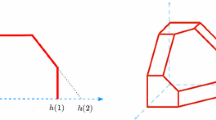Abstract
In this paper, the nonlinear mechanism of phase transition in computer networks is analyzed, and a distributed proxy approach is introduced to improve network performance based on the two-dimensional coupling model. Theoretical analysis figures out that the nonlinear mechanism of router is the essential reason of network performance phase transition. Simulation results reveal that the extreme clustering characteristic of web access behavior gives arise to left-shift of phase transition critical compared with regular networks; after distributed proxy approach is employed, right-shift of the phase transition critical illustrates performance improvement. Finally, several important issues are mentioned.
This work is supported in part by the National Nature Science Foundation of China (NSFC) grants 60672142, 60772053, the National Basic Research Program of China (973 Program) grants 2007CB307100 / 2007CB307105, and by the China Postdoctoral Science Foundation grants 20080430400.
Access this chapter
Tax calculation will be finalised at checkout
Purchases are for personal use only
Preview
Unable to display preview. Download preview PDF.
Similar content being viewed by others
References
Willingers, W., Taqqus, M.S., Shennans, R., Wilson, D.V.: Self-similarity through high-variability: statistical analysis of Ethernet LAN traffic at the source level. IEEE/ACM Transactions on Networking 5(1), 71–86 (1997)
Csabai, I.: 1/f noise in computer network traffic. Physica A 27, 417–421 (1994)
Takayasu, M., Fukuda, K., Takayasu, H.: Application of statistical physics to the Internet traffics. Physica A 274, 140–148 (1999)
Hu, M.-B., Wang, W.-X., Jiang, R., Wu, Q.-S., Wu, Y.-H.: Phase transition and hysteresis in scale-free network traffic. Phys. Rev. E 75, 036102 (2007)
Tretyakov, A.Y., Takayasu, M., Takayasu, H.: Phase transition in a computer network model. Physica A 253, 315–322 (1998)
Ohira, T., Sawatari, R.: Phase transition in a computer network traffic model. Phys. Rev. E 58, 193–195 (1998)
Fuks, H., Lawniczak, A.T.: Performance of data networks with random links. Mathematics and Computers in Simulation 51, 101–117 (1999)
Jian, Y., Yong, R., Feng, L., Xiu-Ming, S.: Phase transition and collective correlation behavior in the complex computer network. Acta Phys. Sin. 50, 1221–1225 (2001)
Feng, L., Xiu-Ming, S., Yong, R.: Long-range correlation in computer network. Acta Phys. Sin. 53, 373–378 (2004)
Feng, L., Yong, R., Xiu-Ming, S.: A simple cellular automata model for packet transport in the Internet. Acta Phys. Sin. 51, 1175–1180 (2002)
Lei, W., Shu-Hua, Z., Jian, Y., Yong, R., Xiu-Ming, S.: Influence of virtual networks to internet collective behavior. Acta Phys. Sin. 56, 36–42 (2007)
Ying, L., Xiu-Ming, S., Yong, R.: Dynamic properties of epidemic spreading on finite size complex networks. Chinese Physics 14, 2153–2157 (2005)
Author information
Authors and Affiliations
Editor information
Editors and Affiliations
Rights and permissions
Copyright information
© 2009 ICST Institute for Computer Science, Social Informatics and Telecommunications Engineering
About this paper
Cite this paper
Yi-Peng, L., Yi-Hua, H., Lei, W., Yong, R. (2009). The Nonlinear Mechanism of Phase Transition in Computer Networks. In: Zhou, J. (eds) Complex Sciences. Complex 2009. Lecture Notes of the Institute for Computer Sciences, Social Informatics and Telecommunications Engineering, vol 4. Springer, Berlin, Heidelberg. https://doi.org/10.1007/978-3-642-02466-5_54
Download citation
DOI: https://doi.org/10.1007/978-3-642-02466-5_54
Publisher Name: Springer, Berlin, Heidelberg
Print ISBN: 978-3-642-02465-8
Online ISBN: 978-3-642-02466-5
eBook Packages: Computer ScienceComputer Science (R0)




